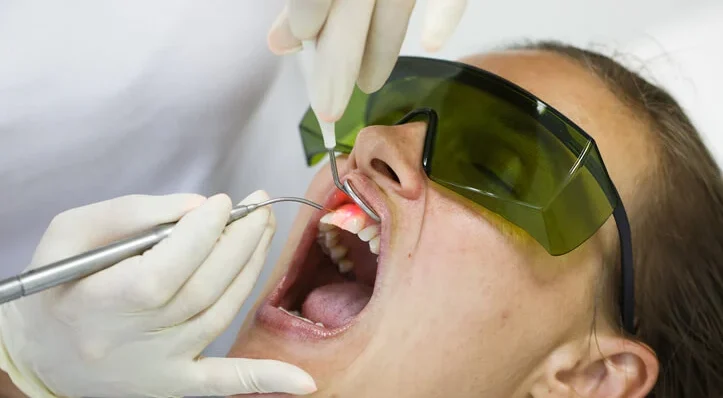Dentinal hypersensitivity is a common dental condition characterized by a sharp, transient pain that occurs in response to various external stimuli, such as cold, heat, osmotic changes, tactile sensations, or chemical exposure. This pain originates from exposed dentine and cannot be attributed to any other dental defect or pathology. The condition is particularly problematic because it affects daily activities, such as eating and drinking, leading to significant discomfort. Among the various treatment options available, laser therapy has gained popularity as a potentially effective intervention for managing dentinal hypersensitivity.
Objectives
The primary objective of this study was to assess the efficacy of in-office laser therapy compared to placebo lasers, placebo agents, or no treatment in reducing the pain associated with dentinal hypersensitivity. This evaluation was aimed at determining whether laser therapy could provide a significant reduction in pain intensity and whether it could be considered a reliable treatment option.
Search Methods
To ensure a comprehensive review, the researchers conducted an extensive search of multiple databases. These included Cochrane Oral Health’s Trials Register, the Cochrane Central Register of Controlled Trials (CENTRAL), MEDLINE Ovid, Embase Ovid, CINAHL EBSCO, and LILACS BIREME Virtual Health Library. The search was thorough, covering databases from their inception to October 20, 2020. Additionally, conference proceedings were reviewed via the ISI Web of Science and ZETOC, and grey literature was sought through OpenGrey. The researchers also searched the US National Institutes of Health Ongoing Trials Register (ClinicalTrials.gov) and the World Health Organization International Clinical Trials Registry Platform for ongoing studies. Importantly, no restrictions were placed on the language or date of publication, ensuring that the search captured all relevant studies.
Selection Criteria
The inclusion criteria for the study were specific and stringent. Only randomized controlled trials (RCTs) that compared in-office lasers to placebo or no treatment were considered. Participants had to be over 12 years of age and diagnosed with tooth sensitivity. This rigorous selection process ensured that the study results would be relevant and applicable to a wide range of patients.
Data Collection and Analysis
The process of data collection and analysis was carried out independently by two review authors, who screened the search results, extracted data, and assessed the risk of bias in the included studies. This independent and duplicate approach was designed to minimize errors and bias in the review process. Discrepancies were resolved through discussion, ensuring that the final analysis was as accurate as possible. For continuous outcomes, mean differences (MD) and 95% confidence intervals (CI) were used. Meta-analyses were performed only on studies with similar comparisons and outcome measures, providing a robust analysis of the available data. The overall certainty of the evidence was assessed using the GRADE approach, which evaluates the quality of evidence and the strength of recommendations.
Main Results
A total of 23 studies were included in the final analysis, encompassing 936 participants and 2296 teeth. The studies varied in their quality, with five assessed at low risk of bias, 13 at unclear risk, and five at high risk of bias. Of these, 17 studies provided data that were used in the meta-analyses. The studies were divided into six subgroups based on the type of laser used and the primary outcome measure.
The primary outcome measure was the change in pain intensity, assessed using a visual analogue scale (VAS) ranging from 0 to 10, where 0 indicated no pain and 10 indicated the worst possible pain. Pain intensity was evaluated in response to air blast and tactile stimuli, and the results were categorized into short-term (0 to 24 hours), medium-term (more than 24 hours to 2 months), and long-term (more than 2 months) effects.
The meta-analysis demonstrated that, compared to placebo or no treatment, the application of all types of lasers combined may reduce pain intensity when tested through air blast stimuli in the short-term (MD -2.24), medium-term (MD -2.46), and long-term (MD -2.60). Similar results were observed for tactile stimuli in the short-term (MD -0.67) and medium-term (MD -1.73), although there was insufficient evidence of a difference in pain intensity in the long term (MD -3.52). Most studies reported no adverse events, indicating that laser therapy is generally safe. However, none of the studies investigated the impact of laser treatment on the quality of life of the participants.
Authors’ Conclusions
The evidence from this meta-analysis, while limited and uncertain, suggests that laser therapy may improve pain intensity when tested through air blast or tactile stimuli across short, medium, and long-term periods compared to placebo or no treatment. However, the evidence was of low to very low certainty, indicating that the findings should be interpreted with caution. Laser therapy appears to be a safe option for managing dentinal hypersensitivity, but further research is needed. Specifically, well-designed double-blind RCTs are necessary to confirm the clinical efficacy and cost-effectiveness of laser therapy for this condition.
Source: Pubmed

